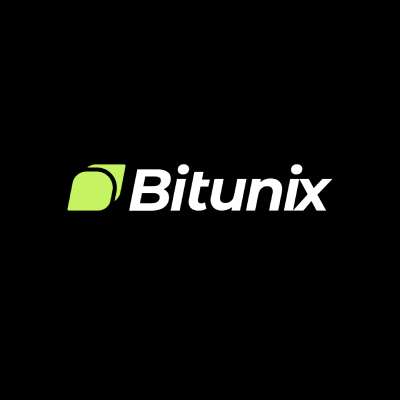Keunggulan eksklusif Warpcast semakin nyata, apakah masih ada peluang di Farcaster?
Penulis asli: Kaori , BlockBeat
Editor asli: Mendongkrak , BlockBeat
Selama akhir pekan, sebuah artikel dari majalah Fortune mengatakan bahwa Farcaster akan meluncurkan token seperti kebanyakan protokol, yang membantu pengguna aktif harian Farcaster, yang telah menurun selama hampir setengah bulan, kembali meningkat. Pada tanggal 22 Mei, Farcaster menyelesaikan pendanaan sebesar $150 juta yang dipimpin oleh Paradigm dengan valuasi hampir $1 miliar. Berita ini sekali lagi menarik perhatian Farcaster dan aplikasi front-end terbesarnya Warpcast, yang telah menarik perhatian pasar di awal tahun. Pengguna aktif harian mencapai rekor tertinggi satu hari setelah pengumuman pendanaan.

Minggu lalu, Voodoo, penerbit game kasual yang terkenal, menghabiskan 500 juta euro untuk mengakuisisi BeReal, aplikasi jejaring sosial untuk kenalan, karena tertarik dengan 40 juta pengguna aktif dan model pertumbuhannya. Voodoo menyelesaikan akuisisi ini dengan pendapatan hampir satu tahun. Siapa pun pemenangnya, hal itu menunjukkan bahwa basis pengguna dan potensi pertumbuhan platform media sosial sangat menarik bagi investor. Hal ini juga dapat membuktikan mengapa Farcaster mampu menyelesaikan pembiayaan sebesar $150 juta dengan valuasi hampir $1 miliar. Dibandingkan dengan valuasi TikTok sebesar 200 miliar, 1 miliar mungkin merupakan ekspektasi wajar yang diberikan oleh VC kripto.
TikTok telah diboikot, Twitter dan Facebook telah menyensor dan memblokir akun secara lebih serius, dan isu geopolitik dan penyensoran telah menjadi tantangan besar yang tak terelakkan akan dihadapi oleh media sosial arus utama saat ini. Situasi ini juga telah memberi ruang bagi munculnya produk sosial yang tahan penyensoran dan terdesentralisasi seperti Mastodon dan Farcaster. Setelah Musk mengambil alih Twitter, jumlah pengguna aktif Mastodon, yang berfokus pada arsitektur terdesentralisasi, meningkat sebesar 600% dalam waktu kurang dari setahun.
Namun, tim inti Farcaster dengan jelas menyatakan bahwa untuk memenangkan pengguna utama, mereka harus terlebih dahulu memenangkan mata uang kripto, dan Farcaster baru mengambil langkah pertama. Berita pendanaan tersebut tidak hanya merangsang DAU, tetapi para pengembang juga menganggap Farcaster sebagai tempat yang menarik, mengembangkan klien, membangun aplikasi vertikal, merancang Frame, dll. Bagi pengguna biasa, bertaruh pada Farcaster untuk menerbitkan koin dan mengoperasikan akun secara aktif adalah cara termudah untuk bertaruh, tetapi bagi pengembang, mengenali pola ekosistem ini dan terlibat mungkin merupakan pilihan terbaik.
Semua orang bekerja untuk Warpcast
Fitur Frames dari Warpcast telah membawa gelombang pertama pertumbuhan pengguna utama, tetapi kendalinya atas fungsi inti telah membuat klien lain hanya berfungsi sebagai ban serep. Kesulitan dalam mengembangkan protokol Farcaster, ditambah dengan pendanaan dan keuntungan pengguna Warpcast, menimbulkan tantangan besar bagi pengembang klien pihak ketiga. Kompetisi ini bukan hanya kompetisi teknologi dan fungsi, tetapi juga eksplorasi masa depan ekosistem sosial yang terdesentralisasi. Dengan dominasi Warpcast yang berkelanjutan dan munculnya aplikasi agregat, prospek ekosistem Farcaster penuh dengan variabel.
Pangeran paling keriting
Pada tanggal 4 Juni, Nook, klien Farcaster yang mendukung aliran informasi yang disesuaikan, mengumumkan bahwa mereka akan berhenti mengembangkan, yang memicu diskusi dalam ekosistem Farcaster tentang kelangsungan hidup klien tersebut. Saat ini, protokol Farcaster memiliki lebih dari selusin aplikasi front-end untuk dipilih pengguna, dengan jumlah total pengguna melebihi 463.000, tetapi lebih dari 90% pengguna menggunakan klien Warpcast yang dibuat oleh Merkle Manufactory, perusahaan pengembangan protokol Farcaster.
Dalam ekosistem pengembang Farcaster, beberapa orang juga menyadari bahwa Warpcast terlalu monopoli dan telah menjadi semacam bayangan dalam ekosistem ini.

Awal tahun ini, Warpcast memperoleh gelombang pertama potensi ekspansi dengan meluncurkan fitur Frames. Frames mirip dengan program mini di WeChat, yang memungkinkan pengguna berinteraksi tanpa meninggalkan aplikasi dan membuka lebih banyak skenario. Selain Frames, Warpcast juga memiliki beberapa fitur inti, seperti Direct Casts dan Channels.
Artinya, jika Anda menggunakan klien protokol Farcaster selain Warpcast, Anda tidak dapat mengirim pesan pribadi ke pengguna lain, dan Anda hanya dapat menelusuri saluran tetapi tidak dapat menerbitkan konten di saluran. Akibatnya, beberapa aplikasi front-end protokol Farcaster hanya dapat menjadi ban serep untuk memberikan bantuan darurat sementara saat Warpcast mati.
Mengembangkan klien protokol Farcaster bukanlah tugas yang mudah. Dan, pendiri protokol Farcaster dan Warpcast, pernah mengatakan bahwa Diperlukan sekitar 20 orang per tahun untuk mengembangkan Warpcast, dan arsitektur intinya tidak jauh berbeda dari aplikasi sosial pada umumnya. Akan tetapi, meskipun demikian, Warpcast tidak sempurna dalam hal algoritma, pencarian, pesan pribadi, dan fungsi lainnya.
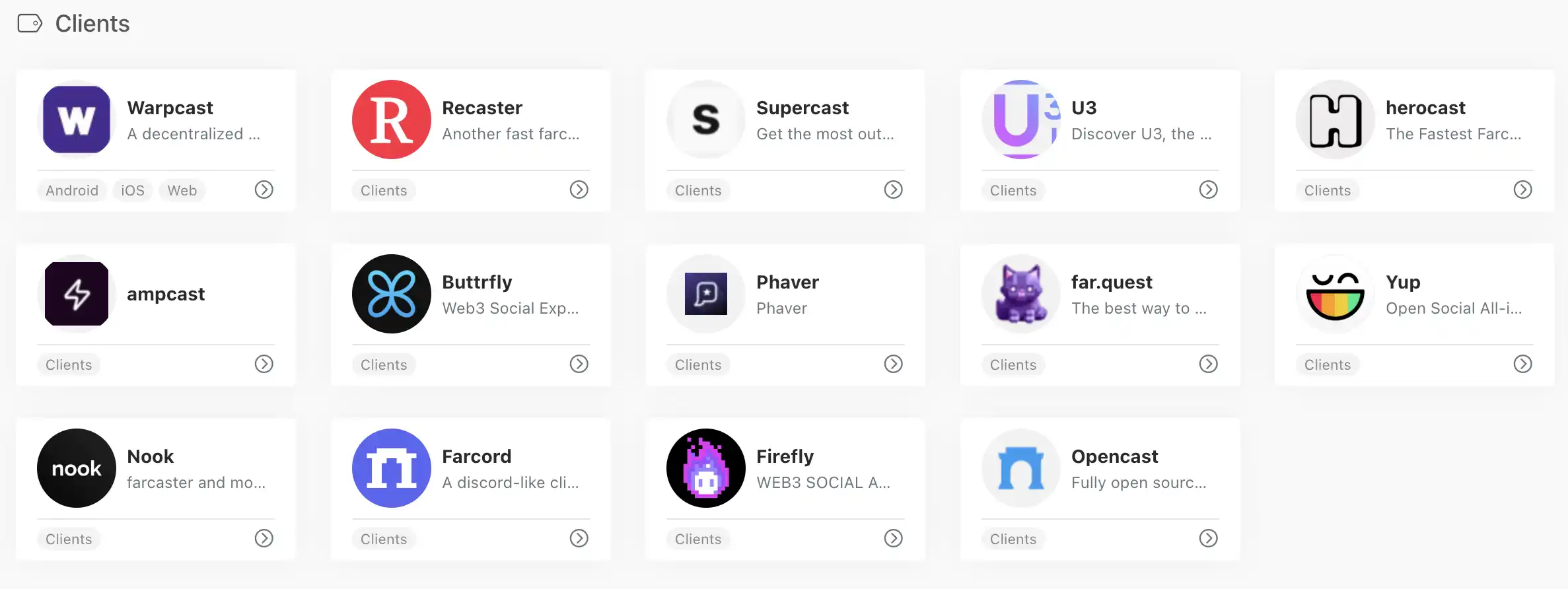
Di sisi lain, klien Farcaster lainnya dikembangkan secara independen oleh tim kecil atau bahkan individu. Beberapa klien ini dimaksudkan untuk meningkatkan fungsi Warpcast. Misalnya, Recaster memiliki fungsi penerjemahan bawaan untuk pengguna non-Inggris, dan Nook, yang telah diumumkan akan ditutup, juga memiliki fungsi khusus untuk menyesuaikan aliran informasi. Supercast, klien terbesar kedua dari protokol Farcaster, dipuji karena pengoperasiannya yang ringan dan pengalaman pengguna yang lebih lancar, tetapi masih belum sepopuler Warpcast dalam hal volume pengguna.
Klien-klien ini berbeda dari Warpcast dan telah berinovasi. Ada juga aliran pengembang yang berambisi untuk menciptakan klien Farcaster baru. Namun, di belakang mereka ada dana baru sebesar $150 juta dari tim Warpcast, dan 90% pengguna menggunakan protokol Farcaster melalui Warpcast. Yang membuat biaya pengembangan menjadi lebih tinggi adalah bahwa protokol Farcaster tidak cukup terbuka. Seorang pengembang menyebutkan kepada BlockBeats bahwa meskipun arsitektur protokol Farcaster lebih ramah daripada Nostr dan protokol lainnya, dokumentasi pengembang tidak cukup lengkap dibandingkan dengan Web2, dan materi tambahan dalam proses pengembangan juga terbatas.
Selain memiliki fungsi yang relatif lengkap dan dukungan sumber daya protokol resmi, persaingan Warpcast dengan klien pihak ketiga juga akan dipengaruhi oleh tren historis integrasi platform yang tak terelakkan dalam pengembangan Internet tradisional. Weibo, Twitter, Facebook, Instagram, LinkedIn, hampir setiap aplikasi sosial Internet arus utama memiliki sejarah bersaing dengan klien pihak ketiga dan menang.
Klien pihak ketiga mereka telah berkinerja baik dalam hal pengalaman pengguna dan fungsi yang berbeda, tetapi klien resmi telah meningkatkan daya saing mereka dengan membatasi panggilan API, merger dan akuisisi, dll., sehingga secara bertahap mengambil posisi terdepan dalam persaingan. Ini juga dapat menjadi jalur persaingan antara klien pihak ketiga Warpcast dan Farcaster di masa mendatang.
Pendiri Nook Kartik mengatakan dalam pengumuman penutupan bahwa Farcaster saat ini hanyalah sebuah platform yang cocok untuk proyek sampingan, bukan perusahaan yang serius, dan ia yakin bahwa tidak ada klien lain yang dapat bersaing dengan Warpcast. Versi alt dari klien Farcaster dapat menjadi inovatif, tetapi sebagian besar waktu orang hanya ingin menjelajahi konten dan berinteraksi dengan pengguna lain. Menurut saya, Warpcast sudah cukup.
Pendiri Airstack, penyedia layanan API protokol Farcaster, juga secara langsung menyatakan, Meskipun siapa pun dapat membangun klien, sebenarnya tidak ada alasan untuk melakukannya kecuali Anda memiliki beberapa wawasan unik tentang kebutuhan pengguna yang belum ditangani oleh Warpcast.
Pandangan umum adalah jika Anda ingin membangun klien Farcaster, harus ada titik masalah atau permintaan yang cukup kuat yang dapat memindahkan sejumlah besar pengguna dari Warpcast ke klien Anda, atau pengguna baru bergabung dan tetap menggunakan klien Anda, atau Anda dapat membangun satu fitur yang benar-benar bernilai yang tidak mungkin dibangun oleh Warpcast sendiri (misalnya streaming video, ruang audio), tetapi berfungsi secara mulus dengan Warpcast.
Singkatnya, mencoba mengganti Warpcast adalah pilihan yang tidak rasional. Tanpa model ekonomi, menjadi klien pihak ketiga lebih seperti bekerja untuk tim Warpcast.
Aplikasi agregat semakin mempersempit ruang
Tantangan yang dihadapi pertumbuhan klien pihak ketiga tidak hanya datang dari Warpcast. Klien agregasi aplikasi yang semakin mendapat perhatian dari masyarakat umum juga telah menjadi pesaing kuat bagi ekosistem Farcaster. Seiring dengan berkembangnya protokol sosial dan menjadi lebih matang, fragmentasi konten akan menjadi masalah yang sudah berlangsung lama seperti fragmentasi likuiditas. Perlunya agregasi sosial belum dirasakan dalam skala besar, tetapi merupakan salah satu masalah utama ekosistem sosial yang terdesentralisasi.
Berbicara tentang klien agregat, yang memiliki akar terdalam adalah Firefly, aplikasi sosial milik Mask Network. Aplikasi ini memiliki berbagai fitur, tidak hanya menggabungkan protokol sosial terdesentralisasi seperti Farcaster dan Lens, tetapi juga terhubung ke Twitter API dengan biaya rendah karena diluncurkan cukup awal. Selain itu, artikel di Mirror dan Paragraph dapat dijelajahi di aplikasi tersebut. Dalam dua bulan terakhir, Buttrfly dan Phaver, salah satu aplikasi front-end terbesar dari protokol sosial utama lainnya Lens Protocol, juga mengumumkan akses mereka ke protokol Farcaster, yang memungkinkan pengguna untuk menerbitkan konten ke Farcaster dan Lens pada saat yang sama.
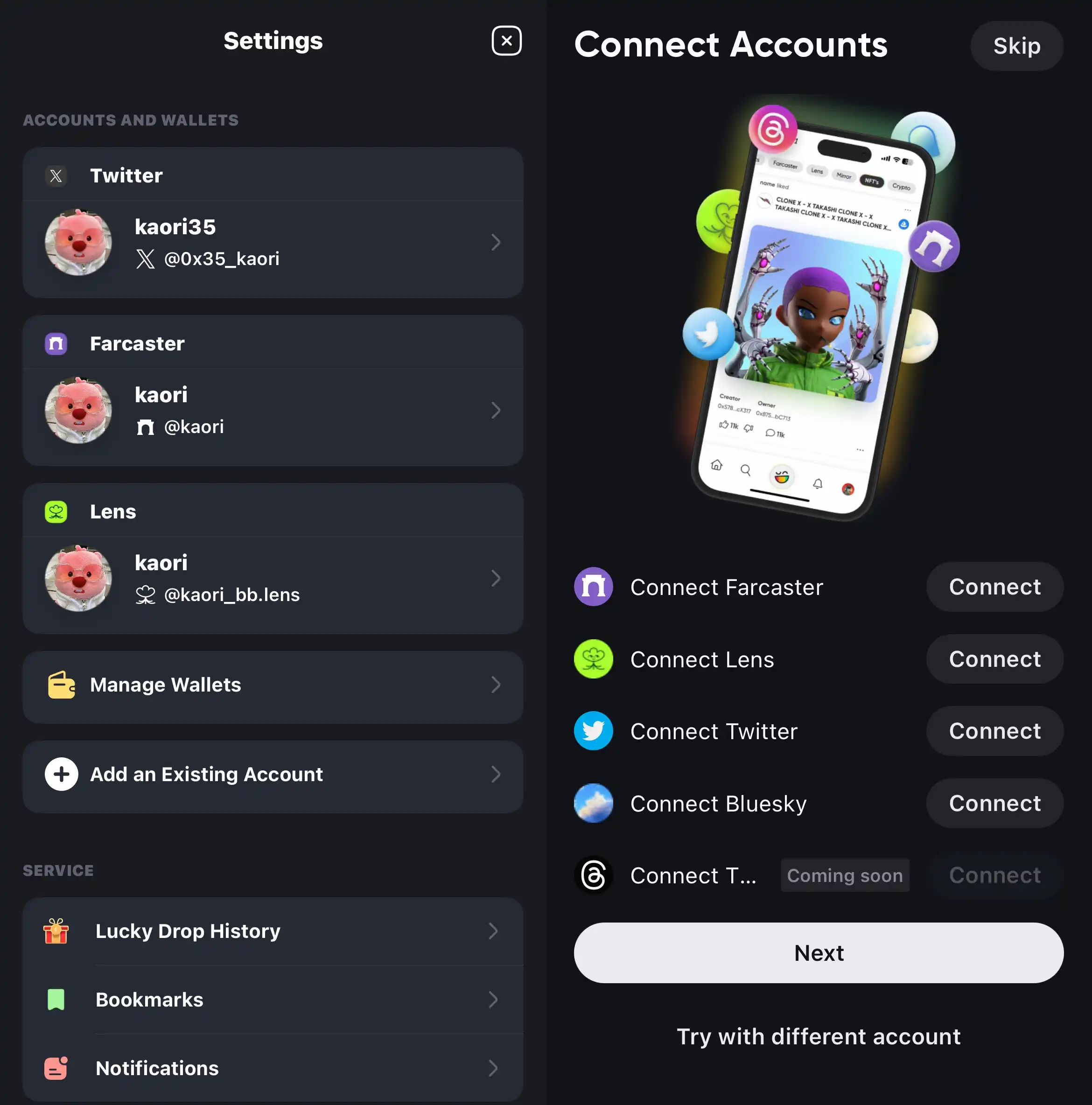
Aplikasi agregasi sosial; kiri: Firefly; kanan: Yup
Vitalik juga disebut-sebut menggunakan klien Firefly. Bagi KOL yang memiliki pengaruh besar pada berbagai platform, pengaturan klien agregat sudah cukup untuk memenuhi kebutuhan sinkronisasi konten di semua platform dengan cara yang paling sederhana.
Selain itu, klien agregasi seperti Firefly juga membangun matriks sosial untuk pengguna individu. Sebagai penjelajah perbatasan Farcaster 0x luo.eth dikatakan , arah Firefly bukan hanya transmisi sinkron, tetapi yang lebih penting, adalah untuk menggabungkan aktivitas on-chain. Tujuan penggabungan adalah untuk mendistribusikan ulang informasi, menghubungkan berbagai grafik sosial, menemukan lebih banyak orang yang tertarik, dan menemukan konten yang lebih menarik.
Klien yang sudah memiliki basis pengguna tertentu akan memiliki proses yang lebih sederhana dan pengalaman pengguna yang lebih lancar saat bergabung dengan Farcaster. Selain itu, Twitter masih menjadi salah satu platform sosial dengan kepadatan konten tertinggi. Bagi sebagian besar pengguna Crypto, keberadaan klien sosial agregat memiliki skenario produk yang jelas, yang selanjutnya menekan pangsa pasar klien asli Farcaster.
Di mana peluangnya?
Protokol Farcaster secara bertahap membuka fungsi intinya, sehingga melemahkan keunggulan eksklusif Warpcast dan mendorong pengembangan lebih banyak klien pihak ketiga. Meskipun ada beberapa tantangan operasional, protokol Farcaster masih dalam tahap awal penemuan dividen.
Warpcast tidak sempurna
Musuh Anda tidak sekuat yang Anda kira. Di Warpcast, Anda sering dapat melihat keluhan tentang operasi diktatornya, seperti kotak hitam lencana aktif dan supremasi bahasa Inggris. Meskipun antarmuka aplikasi Warpcast tidak jauh berbeda dari aplikasi sosial tradisional, pengalaman pengguna jauh dari sempurna. Jika Anda harus berjuang keras untuk aplikasi front-end dan mendapatkan bagian dari kue ini, mungkin merupakan pilihan yang lebih bijaksana untuk menemukan titik terlemah Warpcast dan mengoptimalkannya.
Beberapa hari yang lalu, Dan memulai AMA teks tentang Warpcast, dan seseorang bertanya, Adakah saran untuk penutur bahasa Inggris non-asli yang kesulitan mendapatkan power badge (tanda level aktivitas Warpcast)? Dan tidak memberikan jawaban, tetapi berkata, Jika Anda tidak berbicara bahasa Inggris, maka permainan ini sulit dimainkan. Ia berkata bahwa inti dari Warpcast adalah bahasa Inggris, dan jika Anda bukan penutur asli bahasa Inggris, Anda dapat mengalihkan perhatian Anda ke klien lain. Dalam postingan tersebut, Dan juga menyebutkan produk seperti aplikasi agregasi klien Firefly yang disebutkan di atas.
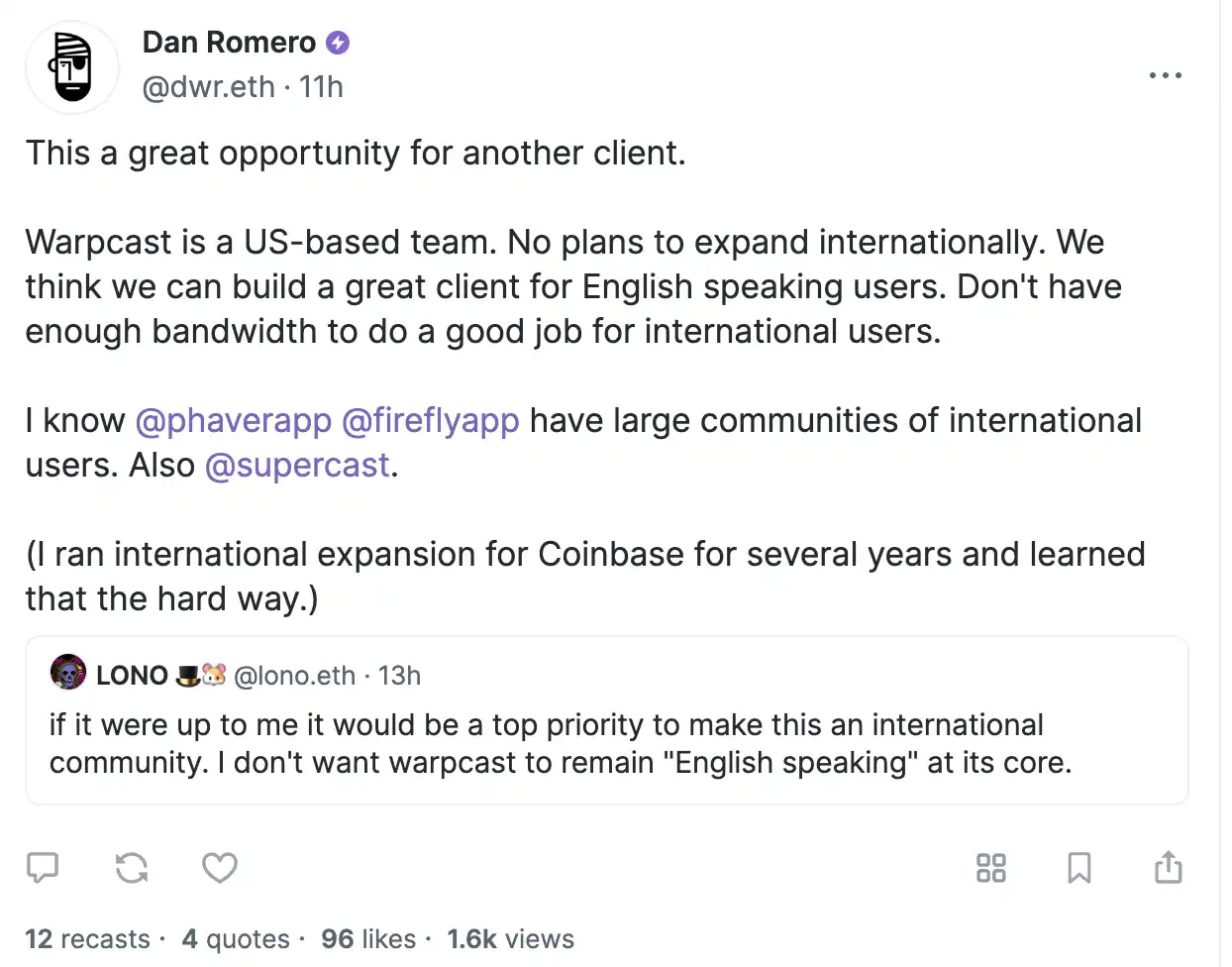
“Warpcast adalah tim yang berbasis di AS dan tidak memiliki rencana untuk berekspansi secara internasional. Kami pikir kami dapat membangun klien yang hebat untuk pengguna berbahasa Inggris karena bandwidth tidak cukup untuk melakukan pekerjaan dengan baik bagi pengguna internasional.” Pernyataan arogan Dan sering membuat pengguna komunitas tidak senang. “Alasan Anda dapat mengumpulkan $150 juta adalah pertumbuhan eksplosif pengguna dari luar Amerika Serikat. Bayangkan jika Jesse Pollak mengatakan Base hanya akan memprioritaskan acara Onchain Summer untuk komunitas AS, apa yang akan terjadi.”
Selain tidak bersahabat dengan pengguna non-Inggris, Warpcast juga dikritik oleh komunitas karena algoritmanya yang monoton dan sistem pemeringkatannya yang tidak transparan.
Untuk memerangi robot dan spam, Warpcast telah mengadopsi pengaturan seperti lencana aktif dan mode prioritas. Pengguna yang mendapatkan lencana aktif didefinisikan sebagai pengguna yang aktif, tertarik pada orang lain, dan bukan spam, tetapi kriteria evaluasinya tidak transparan. Dan mode prioritas berarti bahwa setelah pengguna mengaktifkannya, Anda hanya dapat melihat konten akun yang Anda ikuti, akun dengan lencana aktif, dan akun yang pernah berinteraksi dengan poster tersebut.
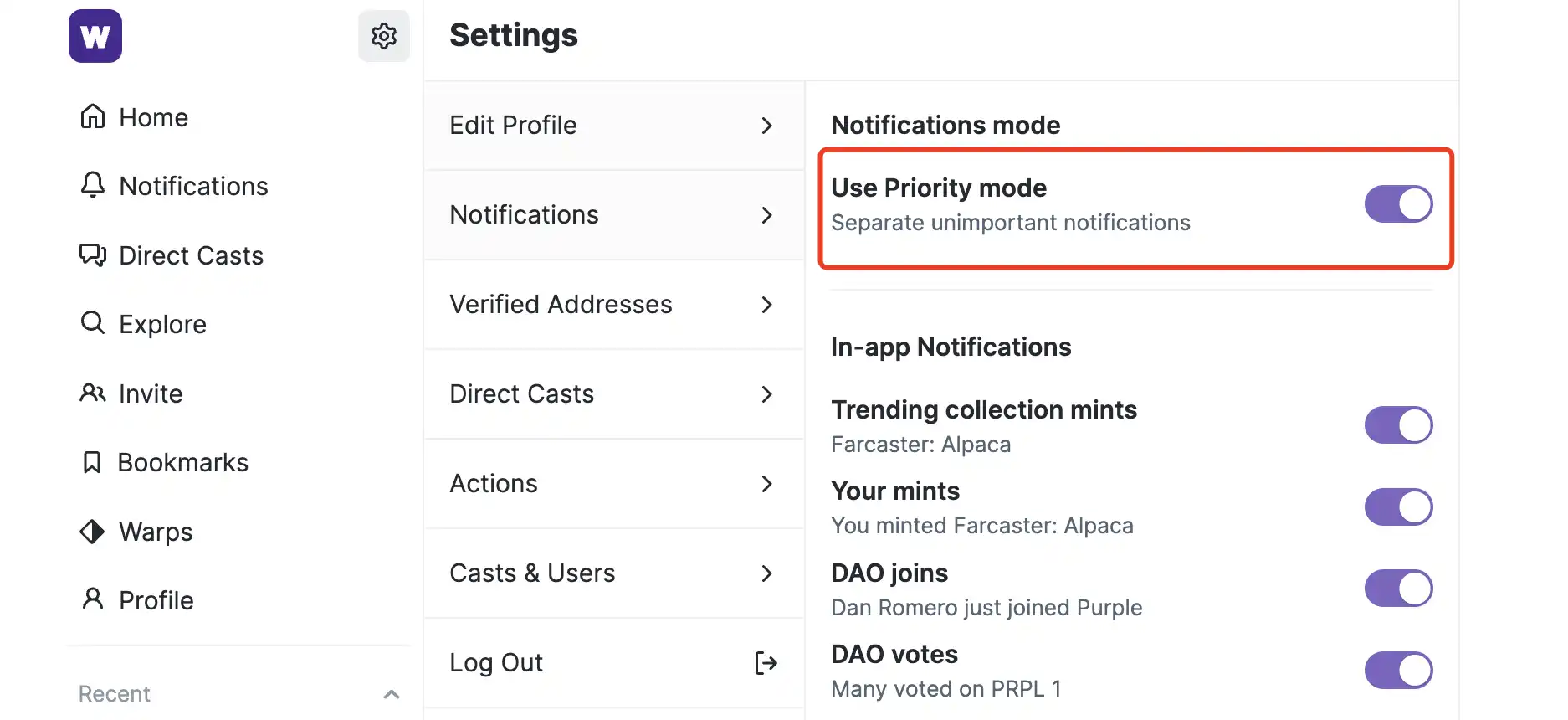
Tombol Mode Prioritas Warpcast
Mode prioritas diaktifkan secara default, yang berarti sulit bagi pengguna baru untuk mendapatkan lalu lintas dan interaksi. Bahkan mereka yang memiliki lencana aktif akan dicabut lencananya jika mereka terlalu banyak berinteraksi dengan pengguna baru. Beberapa orang mulai melihat Warpcast sebagai lingkaran tertutup pengguna lencana aktif, atau ruang gema.
Selain itu, fungsi pencarian Warpcasts kurang memuaskan. Ia hanya memiliki pencarian kronologis yang paling sederhana dan tidak memiliki fungsi pencarian tingkat lanjut seperti Twitter. Tidak ada pula fungsi pencarian di arsitektur inti Warpcasts Channels, yang merupakan kelemahan besar dalam penemuan konten.
Pada awal persaingan media sosial, MySpace adalah pemimpinnya. Namun, Facebook secara bertahap menarik banyak pengguna melalui desain antarmuka yang lebih sederhana dan mudah digunakan, kontrol privasi yang lebih kuat, dan pengalaman yang dipersonalisasi, dan akhirnya berhasil melampaui MySpace untuk menjadi platform jejaring sosial terbesar di dunia. Di jalur mesin pencari, AltaVista pernah memimpin pasar dengan keunggulan teknis dan sejumlah besar pengguna. Namun, Google telah sangat meningkatkan pengalaman pengguna melalui algoritma pencarian yang lebih tepat dan terus mengoptimalkan relevansi dan kecepatan hasil pencarian, yang telah sepenuhnya mengubah lanskap pasar mesin pencari.
Kedua kasus tersebut menunjukkan pentingnya pemikiran produk. Sekalipun tidak ada keuntungan sebagai pelopor, selama Anda benar-benar memperhatikan pengalaman pengguna dan menyediakan layanan yang lebih baik, Anda dapat memperoleh dukungan pengguna dan pengakuan pasar. Untuk produk sosial yang terdesentralisasi, data sosial berada di tangan pengguna, yang berarti bahwa kekuatan pengambilan keputusan juga berada di tangan pengguna. Pengguna akan memberikan suara mereka sendiri tentang produk mana yang bagus.
“Dividen protokol” semakin menguat
Meskipun ada efek Matthew yang serius dari Warpcast, protokol Farcaster kini telah menyadari kebutuhan untuk menjadi lebih terbuka, membawa keuntungan tren bagi pengembang ekosistem.
Gambar di bawah ini menunjukkan seorang pengguna ditanya mengapa ia terpaksa menggunakan Warpcast setelah membeli Supercast. Ia menjawab, Saya hanya dapat menggunakan fungsi pesan pribadi di Warpcast (pendiri Supercast Woj mengatakan perusahaan induk Farcaster, Merkle, tidak ingin berbagi). Selain itu, pengguna tidak dapat bergabung dengan saluran dengan Supercast, dan ada banyak hal yang hanya dapat dilakukan dengan Warpcast.

Seperti disebutkan di atas, fungsi pesan pribadi saat ini terbatas pada Warpcast. Saluran berada dalam status semi-terdesentralisasi. Klien non-Warpcast hanya dapat menampilkan saluran tetapi tidak dapat membuat saluran. Misalnya, jika Weibo adalah Warpcast, maka klien alt tidak memiliki fungsi pesan pribadi, dan hanya dapat melihat topik super, tetapi tidak dapat membuat topik super di klien mereka sendiri.
Dalam pengumuman pendanaan Farcaster, pejabat mengatakan bahwa prioritas berikutnya adalah meningkatkan jumlah pengguna aktif harian dan meningkatkan protokol Farcaster, seperti menambahkan Saluran dan fitur pesan pribadi ke protokol Farcaster itu sendiri.
Di balik insiden ini, kita dapat melihat bahwa Farcaster melemahkan aplikasi dan memperkuat protokol. Membuka fungsi inti sama saja dengan melemahkan Warpcast, dan tidak memiliki keunggulan eksklusif merupakan dorongan bagi klien lain.
Pada saat itu, pengguna juga akan membuat saluran pada klien pihak ketiga, dan semua data dapat dijalankan pada beberapa klien yang berbeda. Ini merupakan hal yang baik untuk klien seperti Supercast yang memiliki basis pengguna tertentu. Dikombinasikan dengan keunggulan Warpcast, diharapkan dapat memengaruhi eselon pertama dalam hal volume pengguna. Untuk klien vertikal berukuran kecil dan menengah, protokol yang lebih terbuka juga akan meningkatkan kebebasan pengembang dan menyelesaikan lebih banyak pengaturan fungsi.
Dengan cara ini, pengembang tidak perlu menciptakan kembali roda, sehingga mengurangi biaya pengembangan. Peningkatan fungsionalitas klien pihak ketiga juga akan melemahkan mentalitas ban serep pengguna, memberi mereka kesempatan untuk bersaing di level yang sama dengan Warpcast.
Buka polanya
Keuntungan awal dari sebuah ekosistem terletak pada penyelesaian masalah protokol. Bagi Farcaster, peningkatan desentralisasi dan pengurangan biaya pengembangan merupakan kebutuhan pengembangan yang mendesak, dan sekarang adalah waktu terbaik bagi para inovator untuk terlibat.
Cukup Terdesentralisasi adalah slogan diusulkan oleh Salah seorang pendiri Farcaster, Varun Srinivasan. Ini juga merupakan tujuan yang ingin dicapai Farcaster, tetapi protokol Farcaster belum dapat sepenuhnya disebut terdesentralisasi saat ini.
Selain lapisan front-end yang langsung dihubungi dan digunakan oleh pengguna, Farcaster juga menyertakan dua Bagian : on-chain dan off-chain. On-chain bertanggung jawab atas registrasi ID, registrasi penyimpanan, dan penyimpanan kunci, sedangkan bagian off-chain adalah server yang terdiri dari Hub. Konsep Hub mirip dengan node pada rantai. Hub berjalan pada perangkat keras tradisional dan bertanggung jawab untuk memproses data yang tidak memerlukan konfirmasi on-chain guna mempercepat respons dan mengurangi biaya transaksi. Tugas utamanya meliputi pemrosesan konten yang diunggah pengguna, penyebaran data yang disinkronkan, dll.
Menjalankan Farcaster Hub sebagian besar merupakan masalah pengembang yang membangun klien atau mengembangkan frame untuk meminta data. Dan menjalankan Hub memerlukan biaya, tetapi lapisan protokol itu sendiri tidak memiliki insentif ekonomi bagi operator Hub. Sampai batas tertentu, ini adalah salah satu alasan mengapa protokol Farcaster tidak begitu terdesentralisasi.
Setahun yang lalu, seorang pengguna bertanya apakah ada insentif untuk mengoperasikan Farcaster Hub, dan Varun menjawab bahwa sebagian besar pengembang aplikasi akan menjalankan Hub, seperti halnya setiap platform perdagangan mata uang kripto menjalankan node. Tidak ada insentif ekonomi karena kami belum menemukan solusi yang tidak mudah dimanipulasi, itulah alasan yang diberikannya untuk tidak memiliki insentif untuk mengoperasikan Hub.
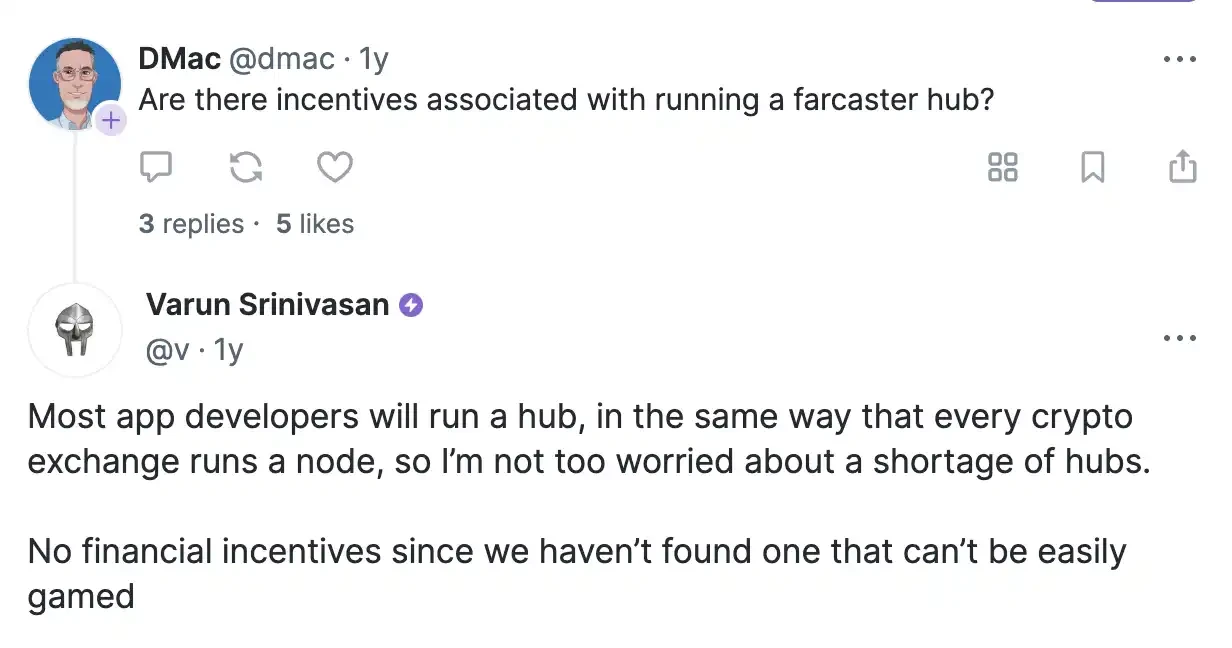
Namun, seiring dengan terus berkembangnya protokol Farcaster, solusi baru untuk masalah insentif telah muncul secara bertahap. Sebelumnya, Hub yang sedang berjalan dapat secara teratur memperoleh beberapa token likuiditas internal Warpcast Warps, meskipun Dan kemudian menangguhkan insentif ini. Pada tanggal 6 Juni, akun resmi EigenLayer meneruskan produk baru AVS yang disebut Ferrule, yang bertujuan untuk memberi insentif kepada orang untuk menjalankan Farcaster Hub dan meningkatkan desentralisasi protokol Farcaster.
Insentif Ferrule adalah bahwa operator Hub mempertaruhkan kembali aset (seperti ETH) ke dalam kontrak Ferrule, dan secara dinamis mendelegasikan aset ke Hub berdasarkan perilaku jaringan. Sebagian dari pendapatan dari staking akan didistribusikan ke operator Hub sebagai hadiah, dan sebagian dari biaya sewa akun penyimpanan juga akan dibayarkan. Operator Hub yang mempertaruhkan ETH ke dalam kontrak Ferrule berarti bahwa aset mereka terikat pada keamanan protokol Farcaster, dan kelambanan Hub atau perilaku jahat akan dihukum secara finansial melalui mekanisme pemotongan.
Bacaan terkait: Bisakah Anda menghasilkan uang dengan menjalankan node Farcaster? Memahami ekonomi re-staking sosial Ferrules
Selain itu, untuk mengelola pertumbuhan status, Ferrule juga memperkenalkan mekanisme sharding dan routing data guna memastikan bahwa tidak ada satu Hub pun yang perlu menyimpan semua data, sehingga beban penyimpanan terdistribusi ke seluruh jaringan. Ferrule juga membuat peta lokasi data guna memastikan pengambilan data yang efisien.
Dengan menggunakan kerangka kerja AVS, Ferrule dapat menambahkan lapisan insentif ke protokol Farcaster. Saat ini, ide yang diusulkan oleh tim peneliti Anagram ini sedang dalam tahap implementasi, dan pengusul juga menyatakan dalam dokumen publik bahwa jika pengembang bersedia menyelesaikan proyek ini bersama-sama, mereka dapat bergabung sebagai EIR (pengusaha tetap di perusahaan rintisan).
Ada banyak startup layanan pihak ketiga lainnya di ekosistem Farcaster, yang telah berkinerja sangat baik dalam hal implementasi dan pendanaan. Yang paling representatif adalah alat pengembang Neynar, yang merupakan finalis untuk a16z Crypto Spring Startup Accelerator tahun ini. Pada tanggal 30 Mei, Neynar mengumumkan penyelesaian putaran pendanaan Seri A sebesar $11 juta dengan partisipasi dari a16z, Coinbase, dan lembaga lainnya.
Sebelum Neynar, satu-satunya cara untuk mengembangkan protokol Farcaster adalah dengan menjalankan Hub, tetapi biayanya mencapai ratusan dolar per bulan. Neyner pada dasarnya mengoperasikan Hub untuk para pengembang, dengan biaya minimum hanya $9 per bulan, sehingga sangat mengurangi biaya pengembang.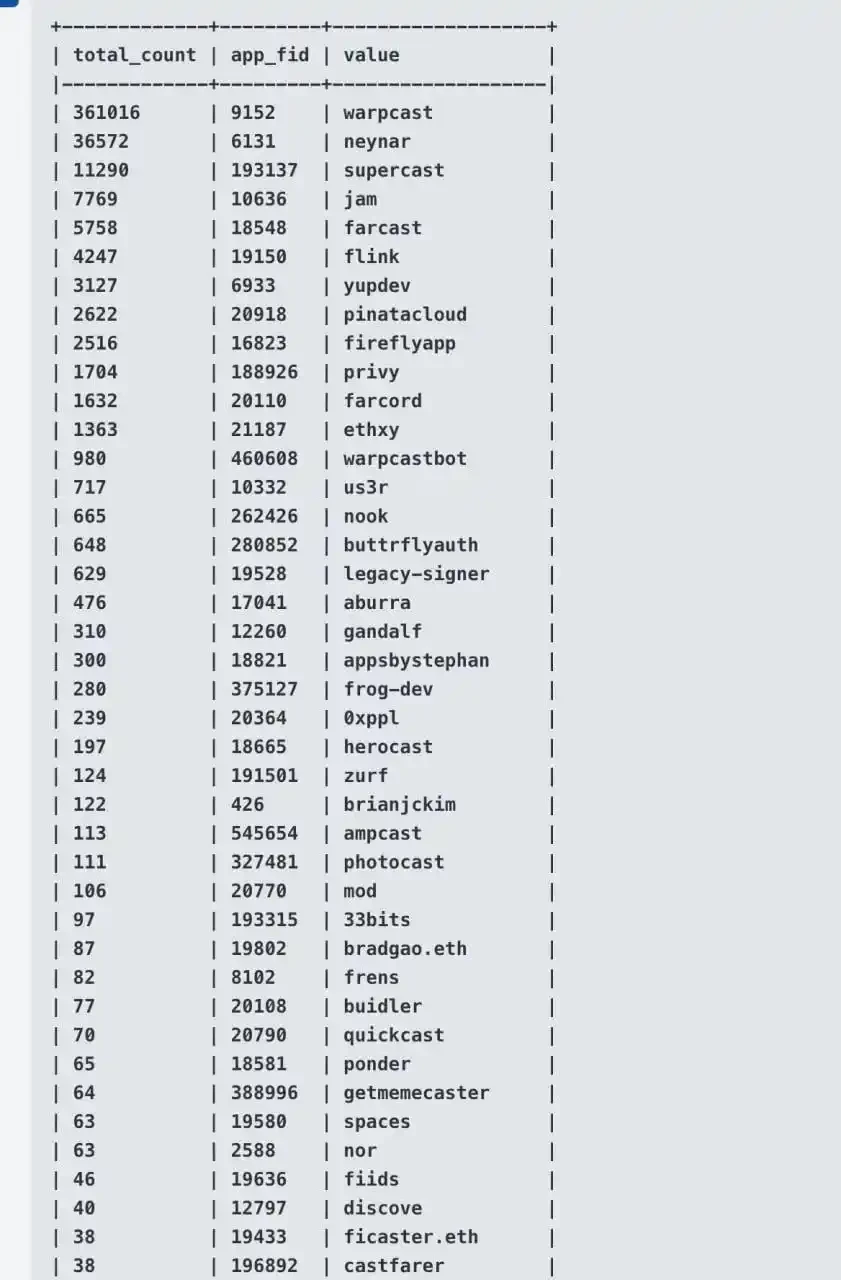
Penyedia layanan API protokol Farcaster, Neynar telah menjadi pihak koneksi pengguna independen terbesar kedua; Sumber: Suji Yan
Selain proyek kewirausahaan ekologi seperti Neynar dan Ferrule, tim Farcaster sendiri juga berkembang isu inti seperti sinkronisasi jaringan, replikasi data, dan pertumbuhan status. Tujuan di balik ini adalah untuk meningkatkan tingkat desentralisasi protokol Farcaster dan mempersiapkan diri untuk gelombang pengguna berikutnya. Oleh karena itu, ekosistem ini masih memiliki banyak kemungkinan yang layak untuk terus dikembangkan secara mendalam oleh pengembang.
Farcaster tidak bisa melihat akhirnya
Dalam frasa "build your own client or use another client" bukanlah penawar untuk membuat protokol Farcaster lebih terdesentralisasi atau menambah jumlah pengguna. Makna terbesar dari keberadaan Warpcast saat ini adalah untuk menyediakan kemungkinan dan tempat bagi pengguna mata uang kripto biasa untuk berkreasi. Bahkan untuk klien agregasi, masih banyak ruang untuk perbaikan dalam fungsi pencarian dan integrasi konten.
Ekosistem Farcaster secara bertahap semakin matang. Keterbukaan protokol, fungsionalitas yang terus meningkat, dan partisipasi aktif komunitas telah meletakkan fondasi yang kokoh bagi pertumbuhan Farcaster di masa mendatang. Saat ini, banyak produk telah diturunkan dari protokol Farcaster, seperti platform kreator Paragraph, aplikasi finansialisasi konten Jam, dan platform tugas komunitas Bountycaster. Ada kemungkinan bahwa banyak produk yang dibuat oleh pengembang di masa mendatang tidak akan disebut klien Farcaster sama sekali. Mereka menggunakan protokol Farcaster tetapi melakukan sesuatu yang sama sekali berbeda.
Perbesar saja kuenya, dan Farcaster tetaplah sebuah keuntungan besar.
Artikel ini bersumber dari internet: Keunggulan eksklusif Warpcast semakin nyata, apakah masih ada peluang di Farcaster?
Terkait: Dengan meledaknya AI, mengapa Web3 sangat diperlukan?
Penulis asli: Teng Yan Terjemahan asli: Luffy, Foresight News Metafora yang pernah saya dengar adalah bahwa AI generatif berarti menemukan benua baru di Bumi dengan 100 miliar orang super cerdas yang bersedia bekerja secara cuma-cuma. Luar biasa, bukan? Abad ke-21 akan dikenal sebagai era kecerdasan buatan bagi umat manusia. Kita tengah menyaksikan perkembangan awal teknologi generasi baru yang akan mengubah masyarakat lebih mendalam daripada penemuan listrik, pemanfaatan energi nuklir, atau bahkan pemanfaatan api. Jangan percaya begitu saja, Raja Inggris pernah berkata: Sungguh masa yang luar biasa! Siapa yang tahu bahwa memberi algoritma sejumlah besar data dan menambahkan sumber daya komputasi yang besar akan memungkinkan AI mengembangkan kemampuan baru yang menakjubkan? Sekarang AI dapat mensintesis, menalar, dan benar-benar…





